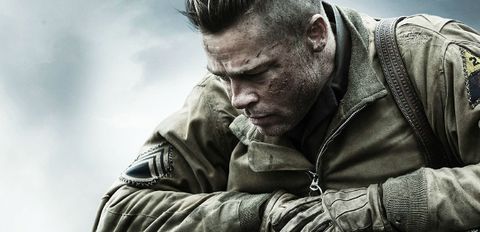Grimy, exhausted and war-weary soldiers crack insensitive jokes about Adolf Hitler as a column of battered tanks make their way across the German countryside. Out of the corner of his eye, a young recruit (Logan Lerman) spies a teenager in the woods, but he hesitates to alert his superiors – or to target the teen and pull a trigger, himself. Within seconds, the quiet scene erupts in chaos. The tank ahead of our amateur spotter is hit with a makeshift Molotov Cocktail, thrown by the enemy in the trees. An American soldier takes a direct hit, and bursts into flames. Rather than allowing the fire to consume him slowly, the man removes a service revolver, points it at his own head, and pulls the trigger.
War is hell. Fury might be worse.
I can’t say that I like David Ayer’s Fury. The movie’s far too mean, impatient, heartless, grueling and cynical to ever embrace (or even recommend). But I begrudgingly admire the director’s intense commitment to the misery of combat, and the atrocities of war. Having never served in a military branch, I can only assume that the stench of death and despair that chokes Fury pulls directly from the charred memories of armed service veterans. But realism – particularly the painstaking recreation of the devastating war-time scenarios found in Fury -- don’t amount to an entertaining sit in a theater. Welcome to suck.
Fury refers to the nickname of the tank commanded by Don Collier (Brad Pitt). The metal beast has been through some devastating shit, and Collier’s composure under horrific conditions has earned him the loyalty and respect of some beleaguered American soldiers. Boyd Swan (Shai LaBeouf) is a religious man who wants to know if his fellows in arms have been “saved.” Grady (Jon Bernthal) is a sadistic bully who lets the insanity of combat excuse some of his despicable behaviors. And Trini (Michael Pena) is a racial stereotype who, sadly, isn’t given much time to develop in between missions.
The movie pivots when fresh-faced Norman (Lerman) is assigned to the tank… despite the fact that he’s a clerk with no experience manning a tank, whatsoever. From there, we wonder if Fury will be about the gradual corruption of Norman’s untarnished soul, or a justification of Collier’s harsh tactics in time of war-related crisis.
The answer is the former, with a healthy dose of the latter. Fury loosely structures itself as a rescue mission, but it’s more interested in analyzing the impact war has on the men asked to murder in the name of God and country. These men are damaged beyond repair at the onset of the movie, and the point of Fury seems to be that no matter how hard they fight, there is no salvation waiting at the end of the tour. You only “win” when you resign yourself to this sad reality.
Technically speaking, Fury is a work of combat art. It adopts the intensity, the brutality and the futility of either Platoon or Saving Private Ryan. Tanks are cinematic challenges, and the graceful obstacle of maneuvering them around battlefields always kept me invested in Fury. It had to be a bitch of a movie to film, and the toll of the shoot clouds the faces of the trained actors who brave these punishing physical and psychological conditions to satisfy their director.
Outside of war aficionados, though, I don’t see Fury appealing to a larger, mainstream audience – even with the grimacing Brad Pitt at the forefront of the marketing campaign. Pitt has been known to dwell in dark territories over the course of his career, and Fury earns its stripes as a brutal death march through grim, war-savaged territories. But it never even attempts to shake that inherent attitude of dejection and discouragement that comes with being an integral cog in a besieged war effort. Fury won’t have audience members. It will have “enlisted” ticket buyers who are strapping in to endure the harsh, bitter realities of the war effort.

Sean O’Connell is a journalist and CinemaBlend’s Managing Editor. Having been with the site since 2011, Sean interviewed myriad directors, actors and producers, and created ReelBlend, which he proudly cohosts with Jake Hamilton and Kevin McCarthy. And he's the author of RELEASE THE SNYDER CUT, the Spider-Man history book WITH GREAT POWER, and an upcoming book about Bruce Willis.
Most Popular




